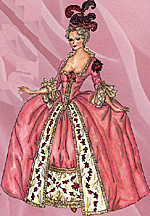
The decadent gowns of the ancien regime contrast with the patriotic dresses of the new Republic
Women who were wealthy enough to follow high fashion in France before the Revolution had opulent, formal wardrobes. In the 1770s, gowns were usually made of silk, satin, or brocade ornamented with lace, ribbons, and embroidery. Full skirts were supported on panniers, or hoops that extended the hips. Bodices were fairly stiff with tight waists, and necklines were often quite low-cut, though sometimes a kerchief covered the bosom. The hair was dressed on pads and scaffolding to give it height and rigidity, and was covered with powder. Various flowers, feathers, jewels, or decorative bonnets embellished the coiffure.
By the 1780s, fashion modified somewhat. The vogue for English tailoring became popular among French aristocrats, and brought fitted jackets and relatively less ornamented gowns into style. This new simplicity also reflected a romantic emphasis on refined sensibilities and pastoral motifs. Skirts were still full, but featured pads or bustles instead of hoops, and lighter, flowing fabrics such as taffeta and muslin became popular. Hair styles featured softer, frizzed, bouffant curls that were sometimes left unpowdered. The emphasis on simplicity was superficial; taffeta and muslin were expensive luxury fabrics, and headgear was still very ornate.
The French Revolution did not change the appearance of women's fashions instantly, but the names given to ensembles in fashion plates (themselves a fairly new innovation) reflected political changes. Gowns bore names such as ‡ la constitution. Bonnets ‡ la trois orderes reunis (a reference to the creation of the National Assembly) and ‡ la Bastille also appeared. The advent of the tricolor made blue, white, and red especially popular colors. For women who disapproved of some of the revolutionary changes, there was an ensemble entitled "catholic" in support of priests who did not accept the Civil Constitution of the Clergy. As the revolution intensified, any vestiges of the formality and artifice of the ancien regime, such as powdered hair and extravagant dress, were denounced as royalist and unpatriotic. Austerity replaced luxury. Plain, French-produced woolens and printed cottons were deemed the most appropriate materials for fashionable patriots, although silk and muslin also remained popular.
More Napoleon: Introductory Guide
-
Introduction
Prejudice and Pride
Napoleon in Military School
The Young Artillerist's Double Life
Revolution & Opportunity
Women's Fashion During the Revolution
The Siege of Toulon
Napoleon & Josephine
Women's Fashion during the Directory
Fame & Glory: Italy
Fame & Glory: Egypt
Saviour or Usurper
Battle of Marengo
Civil Achievments
Enlightened Despot or Tyrant
Napoleon's Siblings
The Dawn of Gastronomy
Haydn and Beethoven
Women's Fashion during the Empire
Napoleon's Other Women
The Mashalate and Imperial Eagle
History's Greatest General?
Back to Table of Contents -- Napoleon #17
Back to Napoleon List of Issues
Back to MagWeb Master Magazine List
© Copyright 2001 by Napoleon LLC.
This article appears in MagWeb (Magazine Web) on the Internet World Wide Web.
The full text and graphics from other military history magazines and gaming magazines are available at http://www.magweb.com
Order Napoleon magazine direct